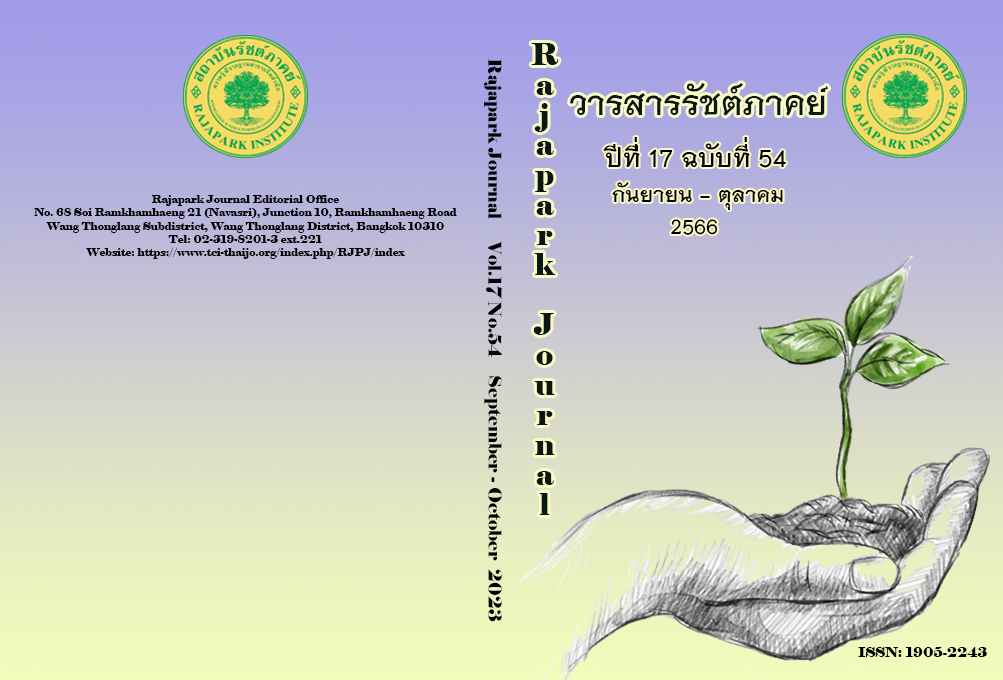การวิเคราะห์ปัจจัยเชิงสาเหตุที่มีอิทธิพลต่อความมั่นคงทางการเงิน และผลตอบแทนหลักทรัพย์ของบริษัทจดทะเบียนในตลาดหลักทรัพย์แห่งประเทศไทย
Main Article Content
บทคัดย่อ
การวิจัยครั้งนี้มีวัตถุประสงค์เพื่อศึกษาปัจจัยเชิงสาเหตุของผลการดำเนินงานด้านการเงิน และผลการดำเนินงานที่ไม่ใช่ด้านการเงินที่มีอิทธิพลต่อความมั่นคงทางการเงิน และผลตอบแทนหลักทรัพย์ของบริษัทจดทะเบียนในตลาดหลักทรัพย์แห่งประเทศไทย รูปแบบของงานวิจัยเป็นแบบเชิงปริมาณและแบบเชิงคุณภาพ กลุ่มตัวอย่างที่ใช้ศึกษาครั้งนี้ คือบริษัทที่จดทะเบียนในตลาดหลักทรัพย์แห่งประเทศไทย โดยเก็บข้อมูลระหว่างปี 2559-2563 มีบริษัทจดทะเบียนที่เป็นไปตามหลักเกณฑ์ในการศึกษาครั้งนี้จำนวนทั้งสิ้น 322 บริษัท การศึกษาใช้การวิเคราะห์อิทธิพลโดยใช้แบบจำลองสมการโครงสร้างเชิงเส้น (Path Analysis) จากการศึกษาพบว่า ปัจจัยผลการดำเนินงานด้านการเงินที่มีอิทธิพลต่อความมั่นคงทางการเงินเชิงบวก ได้แก่ อัตราการโตของกำไรต่อหุ้น และอัตราการโตของรายได้ แต่กลับพบว่าอัตราการโตของผลตอบแทนต่อส่วนของผู้ถือหุ้น มีอิทธิพลในเชิงลบต่อความมั่นคงทางการเงิน ส่วนปัจจัยด้านที่ไม่ใช่การเงินที่ส่งผลต่อความมั่นคงทางการเงิน ได้แก่ การป้องกันและต่อต้านการทุจริต และการกำกับดูแลกิจการ ส่งผลทางตรงเชิงบวกต่อความมั่นคงทางการเงิน และยังพบว่าความมั่นคงทางการเงินยังส่งผลทางตรงเชิงบวกต่อผลตอบแทนหลักทรัพย์ ประกอบด้วย ราคาหุ้น อัตราส่วนราคาหุ้นต่อกำไร และอัตราผลตอบแทนส่วนต่างราคาหุ้น ผลการวิจัยเชิงคุณภาพสอดคล้องกับการวิจัยเชิงปริมาณซึ่งผู้วิจัยได้นำไปพัฒนาเป็นแบบประเมินความมั่นคงทางการเงินเพื่อให้ผู้มีส่วนได้เสียใช้ประกอบกับการตัดสินใจ
Article Details

This work is licensed under a Creative Commons Attribution-NonCommercial-NoDerivatives 4.0 International License.
ทัศนะและความคิดเห็นที่ปรากฏในวารสาร ถือเป็นความรับผิดชอบของผู้เขียนบทความนั้น และไม่ถือเป็นทัศนะและความรับผิดชอบของกองบรรณาธิการ
References
Al-Kassar, T. A., & Soileau, J.S. (2012). Design and Applied Mathematical Model of Measuring Financial Performance Evaluation: Jordan Results. Oil Gas & Energy Quarterly, 60(3), 621-636.
Al-Kassar, T. A. & Soileau, J.S. (2014). Financial Performance Evaluation and Bankruptcy Prediction (Failure). Arab Economic and Business Journal, 9(2), 147-155.
Altman, E. I. (1968). Financial Ratios, Discriminant Analysis and the Prediction of Corporate Bankruptcy. The Journal of Finance, 23(4), 589-609.
Amaral, J. M. (2019). Is Doing Good, Good for You? The Relationship Between Financial Distress and CSR: A Study on Southern Europe[Master of Science in Finance, University Católica, Portuguesa].
Beaver, W. (1966). Financial Ratio as Predictor of Failure. Journal of Accounting Research, 5, 77-111.
Campbell, J. Y., Polk, C., & Vuolteenaho, T. (2010). Growth or Glamour? Fundamentals and Systematic Risk in Stock Returns. The Review of Financial Studies, 23(1), 305-344.
Campbell, J.Y., Hilscher, J., & Szilagyi, J. (2011). Predicting Financial Distress and the Performance of Distressed Stocks, Journal of Investment Management, 9(2), 14-34.
Cihak, M., & Hesse, H. (2011). Islamic Mutual Funds’ Financial Performance and International Investment Style: Evidence From 20 Countries. The European Journal of Finance, 17(9-10), 829-850.
Darrat, A. F., Gray, S., Park, J. C., & Wu, Y. (2016). Corporate Governance and Bankruptcy Risk. Journal of Accounting, Auditing & Finance, 31(2), 163-202.
Deegan, C. (2009). Financial accounting theory. McGraw Hill.
Fedorova, E., Gilenko, E., & Dovzhenko, S. (2013). Bankruptcy Prediction for Russian Companies: Application of Combined Classifiers. Expert Systems with Applications, 40(18), 7285-7293.
Fich, E.M., & Slezak, S.L. (2008). Can Corporate Governance Save Distressed Firms from Bankruptcy? An Empirical Analysis, Review of Quantitative Finance and Accounting, 30(2), 225-251.
Gilson, S. (1989). Management Turnover and Financial Distress. Journal of Financial Economics, 25(2), 241-262.
Hair, J. F., Black, W. C., Babin, B. J., Anderson, R. E., & Tatham, R. L. (1998). “Multivariate data analysis.”. Prentice Hall.
Haniffa, R., & Hudaib, M. (2006). Corporate Governance Structure and Performance of Malaysian Listed Companies. Journal of Business Finance & Accounting, 33(7&8), 1034-1062.
Liberty, S.E., & Zimmerman, J.L. (1986). Labor Union Contract Negotiations and Accounting Choices. The Accounting Review, 61(4), 692-712.
Lin, K.C., & Dong, X. (2018). Corporate Social Responsibility Engagement of Financially Distressed Firms and Their Bankruptcy Likelihood. Advances in accounting, Elsevier, 43(C), 32-45.
Ng, S.T., Wong, J.M.W., & Zhang, J. (2011). Applying Z-score Model to Distinguish Insolvent Construction Companies in China. Journal of International Habitat, 35(4), 599-607.
Nguyen, V.C., Nguyen, T.N., Oanh Le, T.T., & Nguyen, T.T. (2019). Determining the Impact of Financial Performance Factors on Bankruptcy Risk: An Empirical Study of Listed Real Estate Companies in Vietnam. Investment Management and Financial Innovations, 16(3), 307-318.
Ningsih, P.T. & Rahayu. (2018). The Predict of Company Financial Performance Bankruptcy by Ratio, Stock and Z-Score (PT Main TBK). International Journal of Advanced Research, 6(7), 293-303.
Robu, I.B., Robu, M.A., Mironiuc, M., & Balu, F.O. (2014). The Value Relevance of Financial Distress Risk in the Case of RASDAQ Companies. Journal of Accounting and Management Information Systems, 13(4), 623-642.
Saji, T.G. (2018). Financial Distress and Stock Market Failures: Lessons from Indian Realty Sector. The Journal of Business Perspective, 22(1), 50-60.
Stock Exchange of Thailand. (2018). Corporate Governance Policy and Code of Conduct for Market Groups. Securities of Thailand 2021. https://www.set.or.th/en/listing/equities/common-stocks/overview
Tandiontong, M., & Sitompul, M. (2017). The Influence of Financial Distress Using Altman Z-Score, The Beta of Stocks and Inflation to
The Stock Return, Journal of Finance and Banking Review, 2(2), 21-27.
Taffler, R. J. (1983). The Assessment of Company Solvency and Performance Using a Statistical Model. Accounting and Business Research, 13(52), 295-307.
Venkataramana, N., Azash, S., & Ramakrishnaiah, K. (2012). Financial Performance and Predicting the Risk of Bankruptcy: A Case of Selected Cement Companies in India. International Journal of Public Administration and Management Research, 1(1), 40-56.
Vo, Hong Duc., & Nguyen, Minh Tri. (2014). The Impact of Corporate Governance on Firm Performance: An Empirical Study in Vietnam. International Journal of Economics and Finance, 6(6), 1-13.
Zandi, A., Faghani Makrani, K., & Fazeli, N. (2019). Test of Corporate Social Responsibility Engagement Based on Two Approaches to the Exchange Capital and the Moral Capital of Bankruptcy Likelihood. Management Accounting, 12(43), 67-75.

